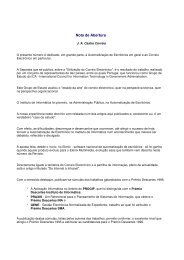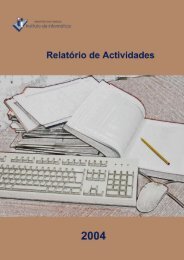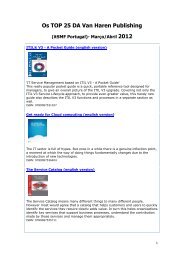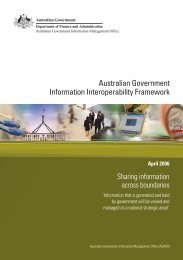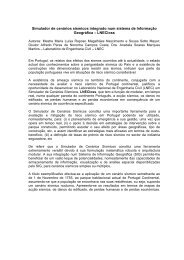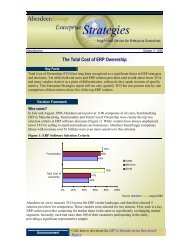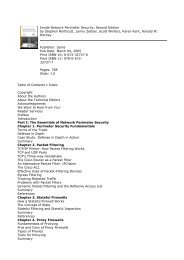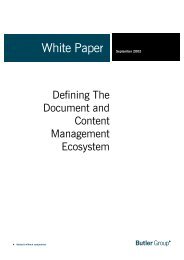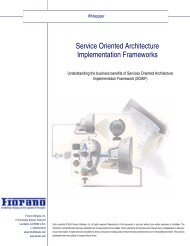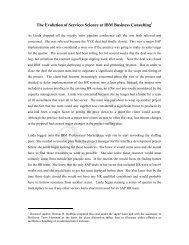OECD Peer Review of E-Government in Denmark - ePractice.eu
OECD Peer Review of E-Government in Denmark - ePractice.eu
OECD Peer Review of E-Government in Denmark - ePractice.eu
You also want an ePaper? Increase the reach of your titles
YUMPU automatically turns print PDFs into web optimized ePapers that Google loves.
CASE STUDY 2: ACHIEVING E-GOVERNMENT READINESS - eDay<br />
The eDay <strong>in</strong>itiative (implemented as eDay and eDay 2) has been a key element <strong>of</strong> the Danish<br />
e-government strategy. Developed under the auspices <strong>of</strong> the Jo<strong>in</strong>t Board <strong>of</strong> e-<strong>Government</strong> with project<br />
leadership provided by the Digital Task Force, eDay is unique among <strong>OECD</strong> countries. The<br />
overarch<strong>in</strong>g goal <strong>of</strong> eDay has been to rapidly achieve government-wide read<strong>in</strong>ess to securely exchange<br />
electronic <strong>in</strong>formation, and create public expectations <strong>of</strong> electronic communication be<strong>in</strong>g the norm for<br />
the public sector.<br />
eDay<br />
The first eDay occurred on 1 September 2003. The goal was to remove the need for paper-based<br />
communications with<strong>in</strong> government as far as possible. All government organisations were given the<br />
right to demand that exchanges <strong>of</strong> <strong>in</strong>formation with other authorities be conducted electronically, and<br />
to refuse to accept non-electronic communications. The only exemptions allowed were for documents<br />
that conta<strong>in</strong>ed identifiable personal <strong>in</strong>formation about citizens, <strong>in</strong>formation which for reasons <strong>of</strong><br />
confidentiality or security can only be communicated electronically us<strong>in</strong>g digital signatures, or preexist<strong>in</strong>g<br />
<strong>in</strong>formation only available <strong>in</strong> paper form. The <strong>in</strong>itiative <strong>in</strong>cluded all State, regional and local<br />
government organisations. Although eDay did not create a right for citizens and bus<strong>in</strong>esses to <strong>in</strong>sist on<br />
digital communication with government, each organisation was encouraged to <strong>of</strong>fer them this ability.<br />
By the end <strong>of</strong> eDay, 100% <strong>of</strong> public authorities had met the criteria required for tak<strong>in</strong>g full<br />
advantage <strong>of</strong> their new right. In October 2003, a survey <strong>of</strong> all government organisations showed that<br />
75% <strong>of</strong> public government organisations both sent and received either no or very few paper<br />
communications that should have been exchanged electronically. The goal <strong>of</strong> eDay was to reduce<br />
paper-based communication across government by 40% with<strong>in</strong> six months. Measurements showed that<br />
this goal was reached. For example, there was a 60% reduction <strong>of</strong> paper-based communication <strong>in</strong> the<br />
M<strong>in</strong>istry <strong>of</strong> F<strong>in</strong>ance after only two months.<br />
For a majority <strong>of</strong> organisations, the first eDay was seen as be<strong>in</strong>g more <strong>of</strong> an organisational than a<br />
technological challenge. One <strong>of</strong> the key issues was the need for effective controls over outgo<strong>in</strong>g and<br />
<strong>in</strong>com<strong>in</strong>g communications, as the choice <strong>of</strong> whether to send <strong>in</strong>formation electronically or on paper is<br />
usually <strong>in</strong> the hands <strong>of</strong> <strong>in</strong>dividual employees. Organisations generally addressed this by decid<strong>in</strong>g to<br />
handle all types <strong>of</strong> <strong>in</strong>com<strong>in</strong>g communications <strong>in</strong> a decentralised way, while manag<strong>in</strong>g all outgo<strong>in</strong>g<br />
communications centrally. Collaboration among organisations over this and other aspects <strong>of</strong> eDay<br />
implementation was one <strong>of</strong> the keys to the success <strong>of</strong> the <strong>in</strong>itiative, enabl<strong>in</strong>g both co-ord<strong>in</strong>ation and a<br />
concerted focus on break<strong>in</strong>g exist<strong>in</strong>g traditions and patterns <strong>of</strong> communication.<br />
eDay 2<br />
eDay 2 occurred on 1 February 2005. Build<strong>in</strong>g on the achievements <strong>of</strong> the first eDay, and the<br />
availability <strong>of</strong> the government public key <strong>in</strong>frastructure, from this date forward all communication<br />
between government organisations, <strong>in</strong>clud<strong>in</strong>g the exchange <strong>of</strong> secret and personal <strong>in</strong>formation, has<br />
been required to be handled electronically wherever possible. On top <strong>of</strong> this, through eDay 2 all<br />
Danish citizens and bus<strong>in</strong>esses were granted the right to <strong>in</strong>sist on electronic communications with<br />
156



